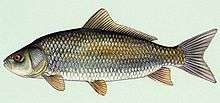Ictiobus
| Ictiobus | |
|---|---|
 | |
| Bigmouth buffalo, Ictiobus cyprinellus | |
| Scientific classification | |
| Kingdom: | Animalia |
| Phylum: | Chordata |
| Class: | Actinopterygii |
| Order: | Cypriniformes |
| Family: | Catostomidae |
| Subfamily: | Ictiobinae |
| Genus: | Ictiobus Rafinesque, 1820 |
| Type species | |
| Catostomus bubalus Rafinesque, 1818 | |
| Species | |
|
See text | |
Ictiobus, also known as buffalo fish or simply buffalo, is a genus of freshwater fish common in the United States, but also found in Canada, Mexico, and Guatemala. They are the largest North American suckers, reaching up to 1.23 m (4.0 ft) in length.[1] They are sometimes mistaken for carp because of the flat face and large, silver scales running along the body, though they lack the whisker-like barbels common to carp. Buffalo fish live in most types of freshwater bodies where panfish are found, such as ponds, creeks, rivers, and lakes. Ictiobus fish were caught by the Lewis and Clark Expedition.
From a fishermen's point of view, the buffalo fish is not a popular game fish because it is difficult to catch. Yet, once on the line, it can put up a good fight. The preferred method of catch is by the use of gill nets. These nets are set by hand during the night, when they are most effective.
Species
Five species are placed in the genus:[1]
- Ictiobus bubalus (Rafinesque, 1818) (smallmouth buffalo)
- Ictiobus cyprinellus (Valenciennes, 1844) (bigmouth buffalo)
- Ictiobus labiosus (Meek, 1904) (fleshylip buffalo)
- Ictiobus meridionalis (Günther, 1868) (Usumacinta buffalo)
- Ictiobus niger (Rafinesque, 1819) (black buffalo)
In popular culture
Buffalo fish was featured in Andrew Zimmern's Bizarre Foods season nine, episode seven, where Zimmern follows a Mississippi River fisherman who catches buffalo fish and deepfries it.
See also
References
- 1 2 Froese, Rainer, and Daniel Pauly, eds. (2011). Species of Ictiobus in FishBase. August 2011 version.
External links
- Ictiobinae Research - Ictiobus
- In Héctor Tobar's 2010 novel Barbarian Nurseries, James "Sweet Hands" Washington remains as the only African-American in a now Hispanic neighborhood because "[He] could still take a couple of buses and find the last place in South Los Angeles that served Louisiana buffalo fish." (p. 182)

- Bizarre Foods Season 9 Episodes 7 Magnificent Mississippi River